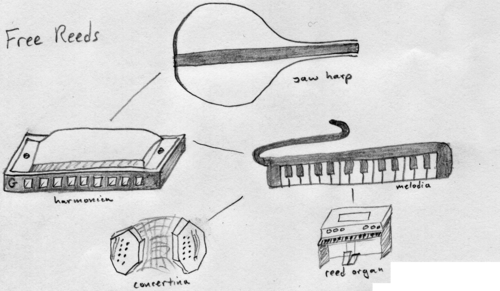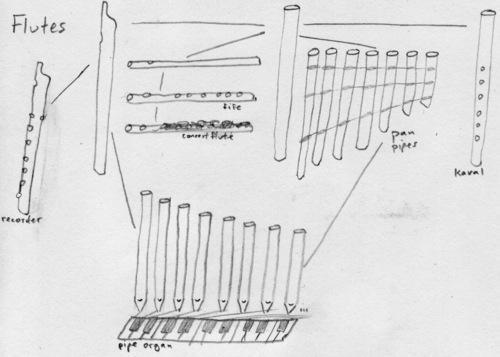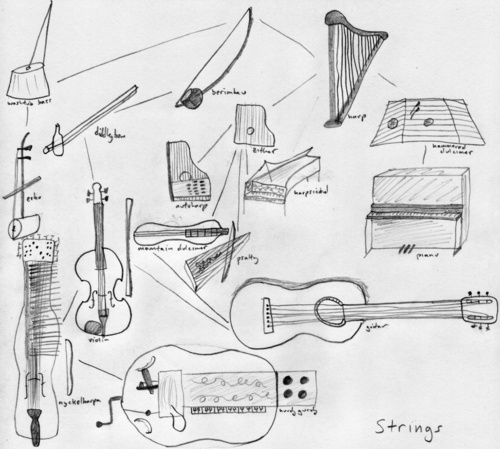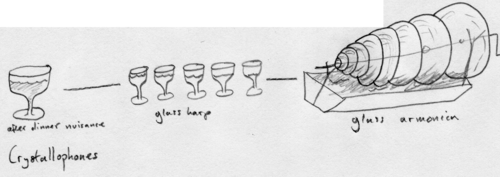Instrument Complexity and Automation |
December 29th, 2011 |
| music |
The problem with the piano or keyboard is that you've traded off a lot of expressiveness for capability. A pianist can choose how hard to hit a key, which changes how the string sounds when it is struck, but that's really it. [1] A violinist, however, can control the vibration of the string continuously, being much closer to directly manipulating it.
This is a tradeoff we see all over the place: a concertina is easier and faster to play than a harmonica, but it has limited control over the sound. The penny whistle and flute, harpsicord and the harp, bombarde and bagpipe; they all follow this pattern. People didn't stop playing the violin after the invention of keyed fiddles, and not just because they're complex and expensive: the farther you get from directly manipulating the sound, the more control you give up and the more your sound is limited. [2]
Seeing this relationship eveywhere, I decided to make some charts. They show, for a kind of instrument, what possibilities there are as you make different tradeoffs on complexity, cost, automation, and capablity. Consider the free reeds:
The jaw harp player, while limited to a single note, has incredible options for percussion and harmonic shapings. The harmonica trades off some of these options for many more notes, while retaining some control over how each note sounds. With the melodica we give up even that texture control, but get something much easier to play.
I made a few more:
The idea is that each instrument is categorized as branching off another that had the musician closer to the creation of the sound. As I made it, however, I realised that some branches added capabiltities without any real tradeoffs (bugle to trumpet). So this doesn't explain everything.
The full set, including others I didn't draw:
no holes end blown flute
pan pipes
pipe organ
kaval
no holes fipple flute
slide whistle
recorder, penny whistle
pipe organ
fife, wood flute
concert flute
shawm
crumhorn
bagpipe
oboe
jaw harp
harmonica
melodica
concertina, accordion
reed organ
didgeridoo
bugle
trumpet, tuba
trombone
bell
xylophone
toy piano
water glass
glass harp
glass harmonica
hornpipe
chalumeau
clarinet
saxophone
berimbau
harp
zither
autoharp
harpsicord
psaltery
mountain dulcimer
hammered dulcimer
piano
diddley bow
violin, viola, cello, bass
guitar, mandolin, ukulele, bass guitar
viola de amor
nyckelharpa
hurdey gurdey
washtub bass
erhu
Update 2013-11-19: The viola organista is another instrument that belongs on this chart. It's a bowed string instrument, where pitch is chosen by selecting from among appropriately tuned strings. It should probably go under the bowed psaltery.
[1] This is reflected in MIDI: a note is defined as a note (0-127) and a velocity (0-127), followed by, some time later, an 'end of note' command. (There are also aftertouch, channel pressure, and pitch bend messages, but your standard midi keyboard doesn't generate them.)
[2] This sounds negative, but I don't mean it that way. The tradeoffs can be good ones: I like that my mandolin has frets because it makes chords much more practical to play in tune. I use a pick because I can play much faster. I like my penny whistle because I'ven't learned how to shape my mouth to play flute.
- Live Music and Technology
- Two Jammer Ideas
- More Rhythm Options
- Approaches to Electronic Contra
- Are Guitars Obsolete?
Comment via: google plus, facebook, r/WeAreTheMusicMakers, substack



